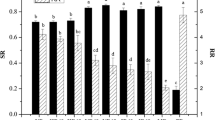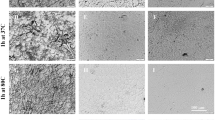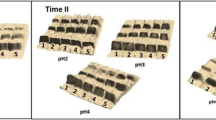Abstract
BACTERIA which have survived freeze-drying retain the capacity to regenerate colonies after prolonged storage under vacuum, in contrast to their rapid loss of this capacity when stored in air. The question of whether bacteria stored under such conditions are dormant or whether some metabolic activity continues to maintain the bacilli in a living state is of fundamental importance to a further understanding of the physiology of life in low-moisture environments. Heckly1 has reviewed many of the problems associated with freeze-drying. Results of preliminary work on freeze-dried cells had indicated a slow gaseous uptake when the material was stored in dry air and a greater uptake if stored under moistened air. Because the results were not reproducible, other techniques were examined, specifically that of electron paramagnetic resonance, in the hope of finding an indirect measurement of respiration. The fundamental theory and practice of electron paramagnetic resonance has been reviewed by Ingram2, while a review of biological applications of the phenomenon has been given by Sands3.
This is a preview of subscription content, access via your institution
Access options
Subscribe to this journal
Receive 51 print issues and online access
$199.00 per year
only $3.90 per issue
Buy this article
- Purchase on Springer Link
- Instant access to full article PDF
Prices may be subject to local taxes which are calculated during checkout
Similar content being viewed by others
References
Heckly, R. J., in Advances in Applied Microbiology, edit. by Umbreit, W. W., 3 (Academic Press, New York, 1961).
Ingram, D. J. E., Free Radicals as studied by Electron Spin Resonance (Butterworths, London, 1958).
Sands, R. H., in NMR and EPR Spectroscopy, 233 (NMR–EPR Staff of Varian Associates) (Pergamon Press, 1960).
Bunting, M. I., J. Bact., 40, 57 (1940).
Heckly, R. J., Anderson, A. W., and Rockenmacher, M., App Microbiol., 6, 255 (1958).
Commoner, B., Townsend, J., and Pake, G. E., Nature, 174, 689 (1954).
Scholes, G., Ward, J. F., and Weiss, J., J. Mol. Biol., 2, 379 (1960).
Yamazaki, I., Mason, H. S., and Piette, L. H., Biochem. Biophys. Research Commun., 1, 336 (1959).
Monk, G. W., McCaffery, P. A., and Davis, M. S., J. Bact., 73, 661 (1957).
Lion, M. B., Kirby-Smith, J. S., and Randolph, M. L., Nature, 192, 34 (1961).
Author information
Authors and Affiliations
Rights and permissions
About this article
Cite this article
DIMMICK, R., HECKLY, R. & HOLLIS, D. Free-Radical Formation during Storage of Freeze-dried Serratia marcescens. Nature 192, 776–777 (1961). https://doi.org/10.1038/192776a0
Issue Date:
DOI: https://doi.org/10.1038/192776a0
This article is cited by
-
Survival of Freeze-dried Leuconostoc mesenteroides and Lactobacillus plantarum Related to Their Cellular Fatty Acids Composition during Storage
Applied Biochemistry and Biotechnology (2009)
-
Impact of polyunsaturated fatty acid degradation on survival and acidification activity of freeze-dried Weissella paramesenteroides LC11 during storage
Applied Microbiology and Biotechnology (2008)
-
Paramagnetic behaviour of the differentiating reproductive apex of wheat
Biophysik (1971)
-
Electron Paramagnetic Resonance in Frozen and Dried Biological Materials
Nature (1967)
Comments
By submitting a comment you agree to abide by our Terms and Community Guidelines. If you find something abusive or that does not comply with our terms or guidelines please flag it as inappropriate.



